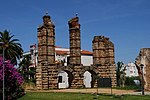Amphitheatre of Mérida

The Amphitheatre of Mérida (Spanish: Anfiteatro de Mérida) is a ruined Roman amphitheatre situated in the Roman colony of Emerita Augusta, present-day Mérida, in Spain. The city itself, Emerita Augusta, was founded in 25 BC by Augustus, to resettle emeritus soldiers discharged from the Roman army from two veteran legions of the Cantabrian Wars (the Legio V Alaudae and Legio X Gemina). The amphitheatre itself was completed in 8 BC. The term emeritus refers to the soldiers, all of whom had been honorably discharged from service. The city became the capital of the Roman province of Lusitania. The amphitheatre is part of the Archaeological Ensemble of Mérida, which is one of the largest and most extensive archaeological sites in Spain. It was declared a World Heritage Site by UNESCO in 1993.
Excerpt from the Wikipedia article Amphitheatre of Mérida (License: CC BY-SA 3.0, Authors, Images).Amphitheatre of Mérida
Calle de Marco Agripa, Merida San Antonio
Geographical coordinates (GPS) Address Nearby Places Show on map
Geographical coordinates (GPS)
| Latitude | Longitude |
|---|---|
| N 38.916194444444 ° | E -6.3377222222222 ° |
Address
Conjunto Arqueológico de Mérida
Calle de Marco Agripa
06800 Merida, San Antonio
Extremadura, Spain
Open on Google Maps










